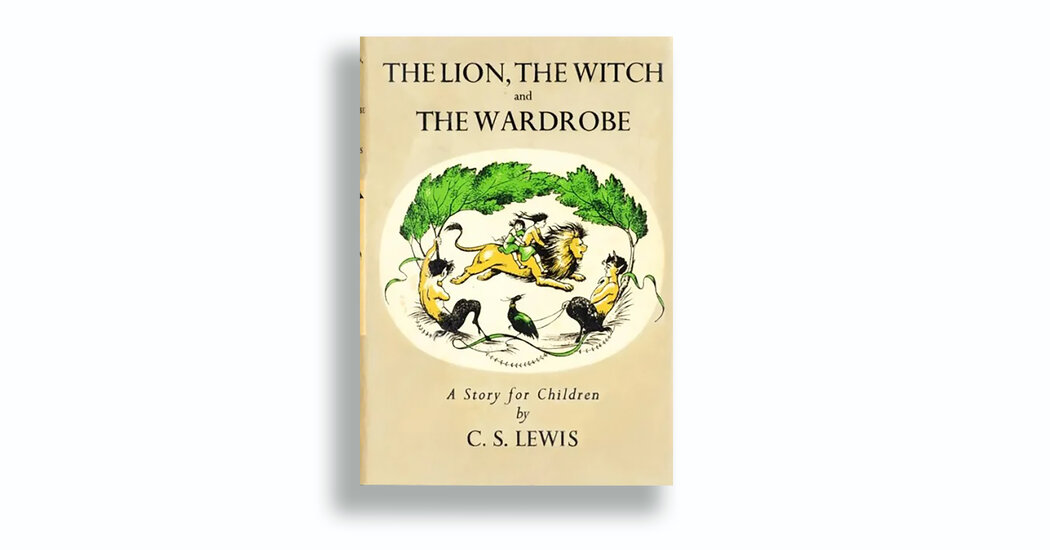One day when C.S. Lewis was a teenager, a curious image flashed across his mind: a parcel-toting faun carrying an umbrella in a snow-covered forest.
Decades later, while a professor at Oxford, Lewis wrote that faun into being as the pointy-bearded Mr. Tumnus, who greets Lucy Pevensie (and readers) as they step into the fantastical world of Narnia in “The Lion, the Witch and the Wardrobe.”
In the 75 years since its U.S. publication, Lewis’s novel has continued to enchant, kicking off the “Chronicles of Narnia” series, which has sold 120 million copies worldwide.
The first book introduces Lucy and her siblings — Edmund, Susan and Peter — who pass through a musty, mothballed wardrobe into a mythical land of talking beavers, a messianic lion and an ill-fated serving of Turkish delight.
I first read “LWW” as a child, on my father’s recommendation. My twin brother and I took turns reading a copy from the public library, passing it back and forth, using different-colored bookmarks to each keep our place.
This summer, while at a writing program at Oxford, I bought a slightly-tattered 1964 edition of the book for £2 at an Oxfam bookstore. Over lamp-lit evenings in my room, I re-entered Narnia for the first time in years.
In the mornings before class, I ran through the leafy parks that surround the campus. How the city’s cobblestone streets so fluidly morphed into wooded, winding paths made it easy to imagine Lewis’s inspiration for the Pevensie children’s inter-world travels.
On my final day, I walked to the famed Bodleian Library where I found in its archives boxfuls of letters that were written to Lewis, most of them by American schoolchildren, in the early 1990s. (It was not clear whether or not they knew he had died in 1963.)
“Your books are life itself,” wrote a young correspondent from Michigan. Joe from Texas wrote: “When I’m tired and think I ought to die, I think, ‘What would Narnia be like if all those brave people gave up?’”
Like children then and now, countless authors also revere “The Lion, the Witch and the Wardrobe,” especially those in the fantasy realm, many of whom consider Lewis’s series to be a cornerstone of the genre. The New York Times Book Review reached out to several about their first encounters with Narnia. Their responses have been edited for clarity.
Katherine Rundell
Author, “Impossible Creatures”
Narnia thrilled me like no other place. It taught me to long for big pleasures: for enchanted landscapes and ancient truths, for redemptions and reversals. The characters felt entirely real; the warmth of Beavers, the fervent gallantry of Reepicheep, and most of all Aslan, about whom Lucy finds it impossible to decide “whether it was more like playing with a thunderstorm or playing with a kitten.”
And I had a school friend who was so passionately in love with Mr. Tumnus that she has ever since found it hard to reconcile herself to dating adult men.
Lev Grossman
Author, “The Magicians” trilogy
Oddly enough I have a personal connection to Narnia, which is that my mother grew up in London during the Blitz, and she was evacuated to the countryside exactly the way the Pevensie children were. She’s never admitted to finding her way into any magic furniture while she was there, but I’ve never entirely let go of the possibility that I am descended from the royal family of Cair Paravel. It would certainly explain a lot.
Like all 10-year-olds I was full of all kinds of huge ridiculous emotions — tragic, heroic, confusing, dramatic feelings — that seemed to have no place in a 1970s elementary school. But when I read “The Lion, the Witch and the Wardrobe” I realized that there was a context for them, namely Narnia, a place that didn’t exist, but in another sense, an emotional sense, was very real.
Rebecca Yarros
Author, “Fourth Wing”
Narnia was my first introduction to both fantasy and binge-reading, and left me wishing for my own hidden armoire.
Katherine Paterson
Author, “Bridge to Terabithia”
My first encounter was in the early ’50s, soon after it was published in the U.S. I had taken it along on the bus our college choir was riding. At some point I began reading it aloud to my fellow songsters and was too hoarse to sing by the time we reached our destination.
I wrote “Bridge to Terabithia” after the death of my son David’s best friend. I decided to try to make sense of that tragedy through writing a story about a similar friendship. It was only after the book was in galleys that I realized “Terabithia” had probably come from reading “Voyage of the Dawn Treader,” where there is an island kingdom called Terebinthia. I was appalled to realize that I had not made up the word Terabithia out of whole cloth, but then, neither had Lewis. When the Angelic messengers visited Abraham, he was sitting beneath the Terebinth tree.
Gregory Maguire
Author, “Wicked”
What may be most wonderful about Narnia to young readers is that kids from our world, those lucky enough to find a wardrobe (or a library card) can cross the borderline from this world to that.
Christopher Paolini
Author, the Inheritance Cycle
“LWW” was the first proper fantasy novel I ever read. I’d tried “Lord of the Rings” … and the Nazgûl scared me so much I had to abandon it for a few years. But “LWW” was just right for my age, and I took to it with enthusiasm.
I still remember that first adventure into Narnia with immense fondness. Oh, how it struck me as a child — the thought of the Pevensie siblings ruling in Cair Paravel until they were grown, only then to return through the wardrobe to their earlier lives. It left me with a bittersweet ache that I’ve come to associate with the best sort of writing.
One need only look at the title of my first story collection, “The Fork, the Witch, and the Worm,” to see the extent of Lewis’s influence on me. I only wish we had more books from him to read.
Kelly Link
Author, “The Book of Love”
My father read Tolkien to me, while my mother read the Narnia books. I trailed around the house after her, begging her for “just one more chapter.”
I was a preacher’s kid, so the Christian overtones in Lewis didn’t throw me. Rather, recognizing them made me feel virtuous — and what child, admit it or not, wouldn’t prefer to meet Jesus in the form of a lion over Jesus in the form of a man?
More so than “The Hobbit” or Tolkien’s books, Lewis’s books felt aspirational. I didn’t want to go on adventures that involved spiders and dwarves and Ringwraiths, much as I enjoyed hearing about them. But I did long to have a closet that led to another world, to meet a faun and to try Turkish delight.
Now I’m old and even more of a hobbit than I used to be, and I still want a closet bigger on the inside than the outside. I’d still like to meet Mr. Tumnus. I have, at least, tried Turkish delight.
Stefano Montali is a news assistant at The Times who contributes reporting across various sections.
The post The First Time I Read ‘The Lion, the Witch and the Wardrobe’ appeared first on New York Times.




